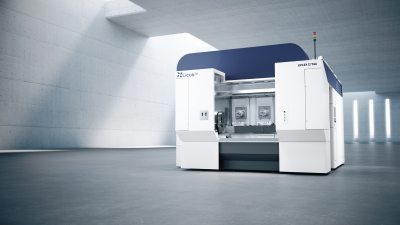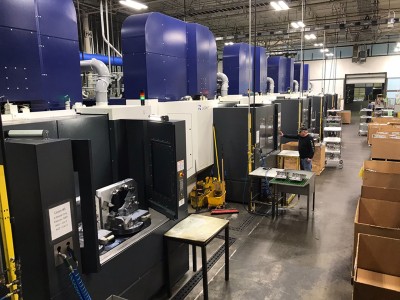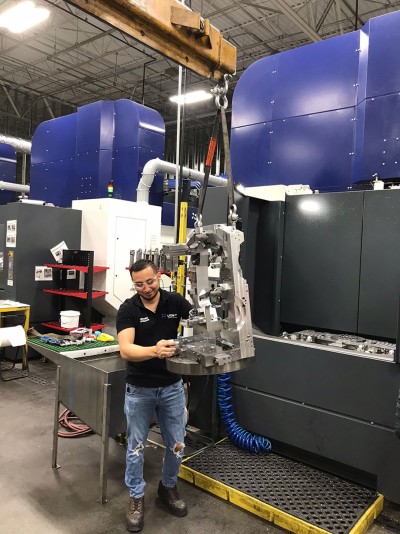High speed and precision for electric mobility
Machining centers from LiCON accelerate the mobility revolution
US specialist for cast components Trace Die Cast trusts in the expertise of German machinery manufacturer LiCON for machining high-precision cast parts for electric drive housings. After a little over 12 months, four highly flexible, twin- spindle machining centers, type LiFLEX II 766 i³, are up and running, with a fifth machine currently being built. With outstanding precision, combined with very short machining times, the high-tech machines from Germany exceed even the highest customer expectations. That is why it pays to take a closer look.

Rapid ramp up curves thanks to the highly flexible 5 axis multi-spindle machining centers
Electric mobility has been booming around the world for some time. A major American electric vehicle manufacturer saw the demand and decided to place a new vehicle model in the expanding market through a project with a very challenging time frame. Just one year was estimated from the start of production until regular production levels would be reached with the maximum output capacity. It was more than an ambitious timeline. For unknown reasons, the original cast parts supplier left the project suddenly, an unexpected development for everyone involved. The moment had come for Trace Die Cast to step in, specialists in high- quality cast parts located in Bowling Green in the US state of Kentucky. Managers quickly saw their opportunity, and knew that there was only one machine manufacturer with the proven expertise in this area needed to meet the high demands for precision and speed. As soon as possible they got in touch with the American branch of LiCON in Dexter (Michigan), and initiated the project.
Highest component precision guarantees optimal, smooth operation
In the German town of Laupheim, LiCON managers realized that this order would pose unique challenges. They very quickly agreed that these technological requirements precisely matched up with LiCON’s core expertise. “We knew that it wouldn’t be simple” says Managing Director Winfried Benz, remembering the start of the project, “but everyone on the team was convinced we could do it.” In particular the production of motor housings, which is the heart of every electric vehicle, demands the highest level of precision. This precision has a direct impact on the ability of e-drives to run smoothly, and therefore effects the everyday operation of the vehicle. “For LiCON as a technological leader in the field of highly flexible, high-speed machining centers, it was a unique challenge to do the impossible in such an extremely rapid timeline” Benz adds.
The highest level of precision thanks to optimal temperature compensation
After a short project planning phase, build of the first two machines began. The project progressed rapidly, which has a lot to do with LiCON's philosophy. This philosophy made it possible to configure machining centers quickly from mainly standardized assemblies in the modular LiFLEX toolbox. Only when the workpiece itself is introduced are individual customer requests and component requirements addressed. This accelerates the throughput time of the machine build, resulting in significantly shorter delivery times.
Workpieces are processed via a highly individualized process. The example of electric motor housings illustrates this well. A total of three different components are produced on the machines delivered to Trace Die Cast. These are the left and right halves as well as the center part of the electric motor housing. The highest level of precision is essential here to ensure the electric drives run smoothly as stated earlier. Quality expressed by the numbers, the machines maintain a positioning precision of 35 micron, which is achieved in volume operation without the use of measuring probes. The flexible machining centers achieve 50 micron in concentricity of opposing bores. Taking into account a 1,67 Cmk requirement, position accuracy goes further up to less than 20 microns – seen over the whole production day. Such high levels of precision can be achieved only through specialized temperature compensation. The i³ series uses a large number of sensors in the relevant machine locations to measure the current temperatures and compensate for fluctuations via developed algorithms. Without this perfect combination of hardware and software, this kind of precision in production processes would be impossible in large scale production.
Dynamic tool monitoring detects potential casting errors
Another technological highlight is dynamic tool monitoring. In comparison to conventional machines, LiFLEX series machining centers offer significant added value over other systems. Detecting broken or worn tools reliably is considered state of the art in modern systems. The development engineers in Germany weren’t satisfied with that standard, however, and continued their research. Through making consistent improvements to monitoring systems, now they are even able to avoid errors when clamping workpieces and exclude collisions with the clamping devices fully in advance. The highly sensitive systems can also reliably detect indications of casting errors, such as blowholes or inclusions of other materials. They do so by interpreting the power consumption through an intelligent process, directly in the motor spindle drive. The motor spindles, which are equipped with numerous other technical features, are developed, produced, and maintained at the in-house spindle center. These and countless other unique selling points make machining centers from LiCON one of the most reliable and secure systems on the market.
LiFLEX i³ series machining centers optimize the supply chain
More and more customers all over the world are benefiting from high-performing centers from Laupheim. Managers at Trace Die Cast in the United States are highly satisfied with twin- spindle machines from the i³ series from LiCON. “The speed at which projects could be carried out, and the extremely high level of production efficiency offered by the machines were the decisive factors for us” says President Chris Guthrie from diecast manufacturer Trace Die Cast. “We are already looking forward to the fifth system from LiCON starting up in our production next week, and we have our eyes on another four-spindle machine we’d like to purchase” Chris Guthrie continues.
More than ever, sustainable production efficiency is a key factor when it comes to satisfying customer needs, and the professionals from Germany are well-equipped to ensure that efficiency. That is why LiCON is so optimistic about the future. Reducing weight and endeavors in different drive technologies are the key drivers of innovation in modern automotive design. Demand for a wide range of components for electric powertrains and large structural components continues to grow. The segment remains dynamic and exciting, which is good for everyone involved in the supply chain.
LiFLEX i³ series
· Multi-spindle machining centers with independent axes
· The highest production efficiency with the best possible flexibility
· Optimized temperature compensation
· Innovative workpiece clamping technologies
· In-house motor spindle construction
· Automation solutions
Download nowDownload the complete success story (PDF file)

Five highly flexible twin-spindle machining centers from LiCON are essential to production at Trace Die Cast in the USA. They are used to produce electric motor housings.

An employee of Trace Die Cast during a setup process. The production team was particularly impressed by the extremely high level of process efficiency.
We are proud to be part of the 02-2022 issue of mav Magazin.
Download nowDownload the success story in German mav issue 02-2022 (PDF file)